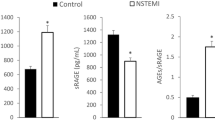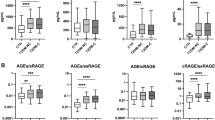Abstract
Interaction of advanced glycation end products (AGEs) with its cell-bound receptor (RAGE) results in cell dysfunction through activation of nuclear factor kappa-B, increase in expression and release of inflammatory cytokines, and generation of oxygen radicals. Circulating soluble receptors, soluble receptor (sRAGE), endogenous secretory receptor (esRAGE) and cleaved receptor (cRGAE) act as decoy for RAGE ligands and thus have cytoprotective effects. Low levels of sRAGE and esRAGE have been proposed as biomarkers for many diseases. However sRAGE and esRAGE levels are elevated in diabetes and chronic renal diseases and still tissue injury occurs. It is possible that increases in levels of AGEs are greater than increases in the levels of soluble receptors in these two diseases. Some new parameters have to be used which could be an universal biomarkers for cell dysfunction. It is hypothesized that increases in serum levels of AGEs are greater than the increases in the soluble receptors, and that the levels of AGEs is correlated with soluble receptors and that the ratios of AGEs/sRAGE, AGEs/esRAGE and AGEs/cRAGE are elevated in patients with end-stage renal disease (ESRD) and would serve as an universal risk marker for ESRD. The study subject comprised of 88 patients with ESRD and 20 healthy controls. AGEs, sRAGE and esRAGE were measured using commercially available enzyme linked immune assay kits. cRAGE was calculated by subtracting esRAGE from sRAGE. The data show that the serum levels of AGEs, sRAGE, cRAGE are elevated and that the elevation of AGEs was greater than those of soluble receptors. The ratios of AGEs/sRAGE, AGEs/esRAGE and AGEs/cRAGE were elevated and the elevation was similar in AGEs/sRAGE and AGEs/cRAGE but greater than AGEs/esRAGE. The sensitivity, specificity, accuracy, and positive and negative predictive value of AGEs/sRAGE and AGEs/cRAGE were 86.36 and 84.88 %, 86.36 and 80.95 %, 0.98 and 0.905, 96.2 and 94.8 %, and 61.29 and 56.67 % respectively. There was a positive correlation of sRAGE with esRAGE and cRAGE, and AGEs with esRAGE; and negative correlation between sRAGE and AGEs/sRAGE, esRAGE and AGES/esRAGE, and cRAGE and AGES/cRAGE. In conclusion, AGEs/sRAGE, AGEs/cRAGE and AGEs/esRAGE may serve as universal risk biomarkers for ESRD and that AGEs/sRAGE and AGEs/cRAGE are better risk biomarkers than AGEs/esRAGE.








Similar content being viewed by others
References
Thorpe SR, Baynes JW (2003) Maillard reaction products in tissue proteins: new products and new perspectives. Amino Acids 25(3–4):275–281
Bierhaus A, Hoffmann MA, Ziegler R, Nawroth PP (1998) AGEs and their interaction with AGE-receptors in vascular disease and diabetes mellitus. I. The AGE concept. Cardivasc Res 37(3):586–600
Tam XHL, Shiu SWM, Leng L, Bucala R, Betteridge DJ, Tan KCB (2011) Enhanced expression of receptor for advanced glycation end-products is associated with low circulating soluble isoforms of the receptors in type 2 diabetes. Clin Sci 120:81–89
Yonekura H, Yamamoto Y, Sakurai S, Petrova RG, Abedin MJ, Li H (2003) Novel splice variants of the receptor for advanced glycation end products expressed in human vascular endothelial cells and pericytes, and their putative roles in diabetes-induced vascular injury. Biochem J 370:1097–1109
Koyama H, Shoji T, Yokoyama H et al (2005) Plasma level of endogenous secretory RAGE is associated with components of the metabolic syndrome and atherosclerosis. Arterioscler Thromb Vasc Biol 25(12):2587–2593
Prasad K (2006) Soluble receptor for advanced glycation end products (sRAGE) and cardiovascular disease. Int J Angiol 15:57–68
Schmidt AM, Yan SD, Stern DM (2000) The biology of receptor for advanced glycation end products and its ligands. Biochem Biophys Acta 1498:99–111
Schmidt AM, Yan SD, Wautier JL, Stern DM (1999) Activation of receptor for advanced glycation end products: a mechanism for chronic vascular dysfunction in diabetic vasculopathy and atherosclerosis. Circ Res 84:489–497
Falcone C, Emanuele E, D’Angelo A et al (2005) Plasma levels of soluble receptor for advanced glycation end products and coronary artery disease in nondiabetic men. Arterioscler Thromb Vasc Biol 25(5):1032–1037
Lindsey JB, de Lemos JA, Cipollone F et al (2009) Association between circulating soluble receptor for advanced glycation end products and atherosclerosis: observations from the Dallas Heart Study. Diabetes Care 32(7):1218–1220
McNair ED, Wells CR, Qureshi AM et al (2009) Low levels of soluble receptor for advanced glycation end products in non-ST elevation myocardial infarction patients. Int J Angiol 18(4):187–192
Santilli F, Bucciarelli L, Noto D et al (2007) Decreased plasma soluble RAGE in patients with hypercholesterolemia: effects of statins. Free Radic Biol Med 43(9):1255–1262
Geroldi D, Falcone C, Emanuele E et al (2005) Decreased plasma levels of soluble receptor for advanced glycation end-products in patients with essential hypertension. J Hypertens 23(9):1725–1729
Emanuele E, D’Angelo A, Tomaino C et al (2005) Circulating levels of soluble receptor for advanced glycation end products in Alzheimer disease and vascular dementia. Arch Neurol 62(11):1734–1736
Smith DJ, Yerkovich ST, Towers MA, Carroll ML, Thomas R, Upham JW (2011) Reduced soluble receptor for advanced glycation end-products in COPD. Eur Respir J 37(3):516–522
Challier M, Jacqueminet S, Benabdesselam O, Grimaldi A, Beaudeux JL (2005) Increased serum concentrations of soluble receptor for advanced glycation endproducts in patients with type 1 diabetes. Clin Chem 51(9):1749–1750
Nin JW, Jorsal A, Ferreira I et al (2010) Higher plasma soluble receptor for advanced glycation end products (sRAGE) levels are associated with incident cardiovascular disease and all-cause mortality in type 1 diabetes: a 12-year follow-up study. Diabetes 59(8):2027–2032
Fujisawa K, Katakami N, Kaneto H et al (2013) Circulating soluble RAGE as a predictive biomarker of cardiovascular event risk in patients with type 2 diabetes. Atherosclerosis 227(2):425–428
Kalousová M, Hodková M, Kazderová M et al (2006) Soluble receptfor for advanced glycation end products in patients with decreased renal function. Am J Kidney Dis 47(3):406–411
Basta G, Leonardis D, Mallamaci F et al (2010) Circulating soluble receptor of advanced glycation end product inversely correlates with atherosclerosis in patients with chronic kidney disease. Kidney Int 77(3):225–231
Nin JWM, Ferreira I, Schalkwijk CG et al (2009) EURODIAB Prospective Complications Study Group. Levels of soluble receptor for AGE are cross-sectionally associated with cardiovascular disease in type 1 diabetes, and this association is partially mediated by endothelial and renal dysfunction and by low-grade inflammation: the EURODIAB prospective complications study. Diabetologia 52(4):705–714
Hammady MMR, Khashali SEL, Halim HA, Rashed L, Hussein M (2012) Soluble receptfor for advanced glycation end products (sRAGE) in non-diabetic hemodialysis patients and chronic kidney disease. Med J Cairo Univ 80:69–75
Taki K, Takayama F, Tsuruta Y, Niwa T (2006) Oxidative stress, advanced glycation end product, and coronary artery calcification in hemodialysis patients. Kidney Int 70(1):218–224
Kilhovd BK, Berg TJ, Birkeland KI, Thorsby P, Hanssen KF (1999) Serum levels of advanced glycation end products are increased in patients with type 2 diabetes and coronary heart disease. Diabetes Care 22(9):1543–1548
Shimoike T, Inoguchi T, Umeda F, Nawata H, Kawano K, Ochi H (2000) The meaning of serum levels of advanced glycosylation end products in diabetic nephropathy. Metabolism 49(8):1030–1035
Raj DS, Choudhury D, Welbourne TC, Levi M (2000) Advanced glycation end products: a Nephrologist’s perspective. Am J Kidney Dis 35(3):365–380
Papanastasiou P, Grass L, Rodela H, Patrikarea A, Oreopoulos D, Diamandis EP (1994) Immunological quantification of advanced glycosylation end-products in the serum of patients on hemodialysis or CAPD. Kidney Int 46(1):216–222
Prasad K (2014) Low levels of serum soluble receptors for advanced glycation end products, biomarkers for disease states: myth or reality. Int J Angiol 23:11–16
Schmidt AM, Stern D (2000) Atherosclerosis and diabetes: the RAGE connection. Curr Atheroscler Rep 2:430–436
Dalal M, Semba RD, Sun K et al (2011) Endogenous secretory receptor for advanced glycation end products and chronic kidney disease in the elderly population. Am J Nephrol 33:313–318
Vlassara H, Striker LJ, Teichberg S et al (1994) Advanced glycation end products induce glomerular sclerosis and albuminuria in normal rats. Proc Natl Acad Sci USA 91:11704–11707
Yamagishi S, Adachi H, Nakamura K et al (2006) Positive association between serum levels of advanced glycation end products and the soluble form of receptor for advanced glycation end products in nondiabetic subjects. Metabolism 55:1227–1231
Santilli F, Vazzana N, Bucciarelli LG et al (2009) Soluble forms of RAGE in human disease: clinical and therapeutic implications. Curr Med Chem 16:940–952
Caspar-Bell, Dhar I, Prasad K (2016) Advanced glycation end products (AGEs) and its receptors in the pathogenesis of hyperthyroidism. Mol Cell Biochem 414(1):171–178
Ubarri J, Kai W, Pebba M, Goodman S, Ferruci L, Striker G, Vlassara H (2007) Circulating glycotoxins and dietary advanced glycation end products: two links to inflammatory response, oxidative stress, and aging. J Gerantol Ser A 62:427–433
McNair E, Qureshi M, Prasad K, Pearce C (2016) Atherosclerosis and hypercholesterolemic AGE-RAGE axis. Int J Angiol 25:110–116
Mook-Kanamori MJ, Ed-Din Selim MM, Takiddin AH, Al-Homsi H, Al-Mahmond KAS, Al-Obaid A, Zine MA, Row J, Gherbi WS, Chidiac OM, Kador SA, Al-Muftah WAA, McKean C, Suhre K, Mook-Kanamori DO (2013) Ethnic and gender differences in advanced glycation end products measured by skin auto-fluorescence. Dermatoendocrinol 5:325–330
Acknowledgments
We acknowledge the help of Dr. H. Lim, Director of Clinical Research Support Unit of the Department of Community Health and Epidemiology, for statistical analysis.
Author information
Authors and Affiliations
Corresponding author
Ethics declarations
Conflicts of interest
The results presented in this paper have not been published previously in whole or part, even in the abstract format. There is no conflict of interest.
Rights and permissions
About this article
Cite this article
Prasad, K., Dhar, I., Zhou, Q. et al. AGEs/sRAGE, a novel risk factor in the pathogenesis of end-stage renal disease. Mol Cell Biochem 423, 105–114 (2016). https://doi.org/10.1007/s11010-016-2829-4
Received:
Accepted:
Published:
Issue Date:
DOI: https://doi.org/10.1007/s11010-016-2829-4




